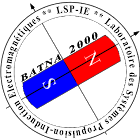, “Incipient Inter-Turn Short Circuit Fault Estimation Based on a Faulty Model Observer and ANN-Method for Induction Motor Drives,” Recent Advances in Electrical & Electronic Engineering (Formerly Recent Patents on Electrical & Electronic Engineering), vol. 12 N° 4, pp. 374-383, 2019.Abstract
Équipe 02
, “dSPACE Validation of Improved Backstepping Optimal Energy Control for Photovoltaic Systems,” 6th International Renewable and Sustainable Energy Conference (IRSEC). pp. 1-6, 2018.Abstract
, “Comparative study between luenberger observer and extended kalman filter for fault-tolerant control of induction motor drives,” International Information and Engineering Technology Association, vol. 73 N 2, pp. 29-36, 2018.Abstract
, “Novel Speed and Current Sensor FDI Schemes with an Improved AFTC for Induction Motor Drives,” Advances in Electrical and Electronic Engineering , vol. 16, pp. 1–14, 2018.
, “Optimal Energy Control of Induction Motor Standalone Photovoltaic-Battery Pumping System,” 6th International Conference on Systems and Control. 2017.
, “Speed Sensor Faults Diagnosis in an Induction Motor Vector Controlled Drive,” Acta Electrotechnica et Informatica , vol. 17, pp. 49–51., 2017.
, “DIRECT S-POWER CONTROL FOR A DOUBLY FED INDUCTION GENERATOR,” Rev. Roum. Sci. Techn.– Électrotechn. et Énerg, vol. 62, pp. 365–370, 2017.
, “Nonlinear Control of the Doubly Fed Induction Generator used with Wind Turbine for an Isolated Grid,” 17th International conference on Sciences and Techniques of Automatic control & computer engineering , STA'2016. 2016.
, “A new flux rotor based MRAS for sensorless control of induction motor,” 5th International Conference on Systems and Control (ICSC), Marrakesh, Morocco. pp. 365-370, 2016.Abstract
, “A novel combined MPPT-pitch angle control for wide range variable speed wind turbine based on neural network,” International Journal of Hydrogen Energy, vol. 41 N 22, pp. 9427-9442, 2016.Abstract
, “PMSM Model with Phase-to-Phase Short-Circuit and Diagnosis by ESA and EPVA,” Advances in Electrical and Electronic Engineering, vol. 14 N 5, pp. 522-530, 2016.Abstract
, “Robust Backstepping MPPT for Photovoltaic System,” 3rd International conference on green energy & Environmental engineering GEEE’2016. 2016.
, “On-Line Efficiency Improvement of Induction Motor Vector Controlled,” Advances in Electrical and Electronic Engineering journal, vol. 14, no. 3, 2016.
, “Sensorless Fault-Tolerant Control of an Induction Motor Based Electric Vehicle,” Journal of Electrical Engineering & Technology JEET, JEET, vol. 11, no. 5, pp. 1423-1432, 2016.
